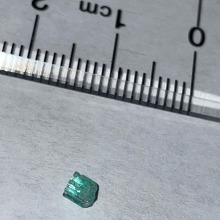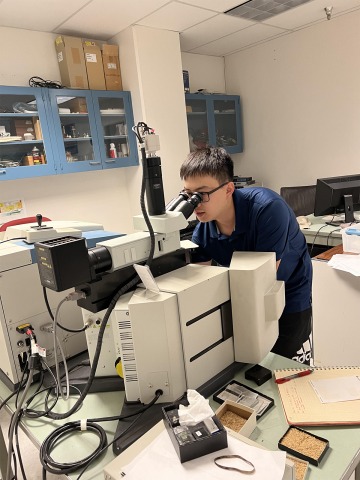Newest Geoscience Track Meets the Needs of the Gem Industry

Over millions of years, the Earth has evolved through a changing climate and geological events. Gems are windows to the past, showcasing how Earth’s history has led to their composition.
At the University of Arizona, the highly-ranked Geosciences program features a one-of-a-kind track in Gem Sciences. In this program, students can focus their skill sets to become gemologists and work toward their passion in the gem industry.

Emerald sample used in provenance testing
The track was created through the leadership of Dr. Ananya Mallik, Assistant Professor in Geosciences and The RealReal, Inc. Endowed Chair in Gem Science.
“There is a need in the gem trade and industry for people who are trained in hardcore science and apply them to problems that are of relevance in the gem industry,” says Mallik. Six students are now in the major track which was created in Fall of 2021.
Danny Svoboda, first graduate of the gem sciences track, switched to the track from geology because of his interests in gems and crystals and how they’re formed. “I enjoy the natural color and beauty of gemstones and I am also a rockhound and collect minerals and crystals in the field, and wire wrap them into jewelry, so I am naturally interested in the gem industry as a career path,” says Svoboda.
He now works at TheRealReal Inc. as a Jewelry Lab Technician where he tests and examines certain gems. “I utilize the XRF (x-ray fluorescence) machine to test the metal content of jewelry and to test certain stones like turquoise, pearls and corals. I also use the Raman spectrometer to authenticate the gemstones set in the jewelry. I also regularly use the tools of the gem trade like a gem microscope, polariscope and refractometer.”

Undergraduate student Tom Zhang uses the Raman spectrometer for identifying gems and minerals
The track is interdisciplinary. While its main focus is geology, there are also classes that students can take from other fields, such as art, retail, chemistry, engineering, and more. Some of the skills students learn involve provenance determination research (determining where gems originate from).
In this track, students will have a lot of opportunities to learn about various aspects of the gem industry, as well as meet with guest speakers. In some of the classes offered, the Alfie Norville Gem & Mineral Museum provides students with hands-on experiences in their classroom, allowing students to practice gem identification.
While many students interested in gem science wish to go into the gem industry upon graduation, there are countless opportunities with this track. Students could go beyond their undergraduate studies, pursuing higher education, and even finding ways to get involved in research with national institutions with a focus in geology. “At the end of the day, you’re a geologist,” says Mallik.
More info - link to external websites:
Alfie Norville Gem & Mineral Museum
Gem Science Major Emphasis on the College of Science Geosciences website

